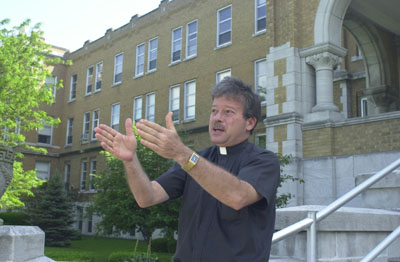By Betty Lawrence
blawrence@dailystandard.com CARTHAGENA -- For the first time, the panoramic St. Charles Center is opening its doors for public living quarters.

A $4.6 million renovation project, beginning next week, will convert the facility into a senior citizen independent living center to open in the fall of 2005.
Facility Director, the Rev. James Seibert, says the change will allow the center to remain financially solvent. The center, located nine miles south of Celina on U.S. 127, currently is a retirement facility for Catholic priests and brothers of the Missionaries of the Precious Blood.
"Basically, our operating expenses have gone up and our population has gone down. The way things stand now, we won't be able to afford to run it in the future if we don't do something now," Seibert said while walking the grounds Tuesday. "The place is too big and we saw this as a way we can continue to stay here and take care of our own people while opening it to the community at the same time."
Bruns Building and Development Corp., St. Henry, is the general contractor that will convert the residential portion of the 105,900-square-foot main building into 55 one and two-bedroom senior apartments. The center will continue to house the 58 priests and brothers who live there. Seibert said 24 of the priests are in the infirmary, and the others live in the main building and plan to move into the new apartments. Therefore, about 20 of the new apartments will be rented to the public.
Work on phase one of the project begins next week with construction of the apartments. The apartments will be rented on a monthly basis, however, the price has not been set yet.
The apartments will consist of a kitchen, bath, living area, dining area, office area and either one or two bedrooms. One-bedroom apartments will be approximately 660 square feet, and the two bedroom living quarters, 875 square feet.
Other changes in phase one include an underground gym raised to ground level and turned into an exercise room, complete with jacuzzi, and the addition of an elevator for the upper floor apartments.
The heating, now hot water heat from a coal fired furnace, will be converted into electric, and central air conditioning will be added.
Water service will be provided by the village of St. Henry to replace the current wells. The plan, still in the works, has St. Henry tapping into a new well field near Burkettsville (on land owned by St. Charles) and then running water lines from Burkettsville to St. Henry to St. Charles. The $600,000 project would be split between the village and St. Charles.
Phase two, now under consideration, includes new meeting rooms, improvements to the acoustics, lighting and handicapped accessibility in the chapel, the addition of guest rooms and new parking lots.
A seven-member St. Charles Development Committee, chaired by Seibert, has been meeting on a regular basis since 1998, working on the renovation and looking at all possibilities.
"The committee looked at every option before settling on this course. We even considered selling it, but we've been a part of the community for such a long time and we felt the people of the area would see that as a real loss," Seibert said. "When you're dealing with a religious community you have to get the okay from all membership. It's not like selling a house by one owner, or a business. There are over 200 member priests and brothers in our province, so it's been a complicated process."
St. Charles now employs about 40 full and part-time lay people, who work in all facets at the center, from the infirmary to the cafeteria. Seibert said an apartment manager will be added after the renovations are complete.
The residential change will create a unique community -- a mix of retired priests and brothers and the public, which Seibert feels will be beneficial to everyone.
"They will become a part of St. Charles. We want people to feel this is their home and not feel like a visitor. We will work hard to make that happen. The lay people will share a meal daily with the priests and brothers and will be invited to be part of all the daily religious services that are part of life at St. Charles," he said.
He feels the project will renew life at St. Charles, along with giving senior citizens a relaxing place to live and an opportunity to use their skills.
"They may want to use those skills, such as gardening, in some way and we can find a place here for them to feel needed," he said. "Senior citizens still have a lot to contribute and I see blending lay with religious as an opportunity for all of us to grow and learn. It will be a wonderful exchange."
The colossal four-story main building at St. Charles was built in 1922 as a seminary for preparing people for the priesthood. The seminary closed in 1969, and since then, the facility has served as a retirement center for priests and brothers. The facility is funded by the Missionaries of Precious Blood, based out of Dayton, who will continue to run the operation after the renovation.
"We're making these changes to offset our expenses. We're not looking to make money," Seibert said. "We just want to try to stay in existence." |

